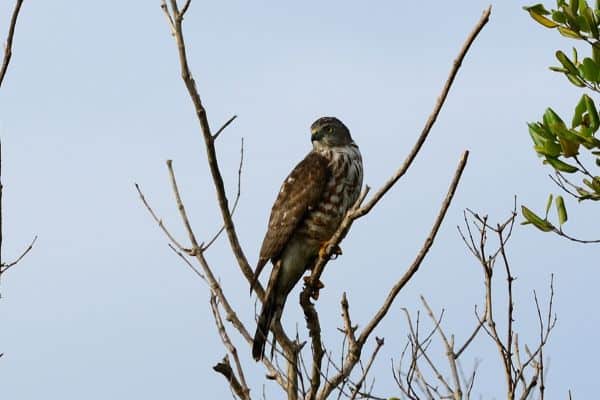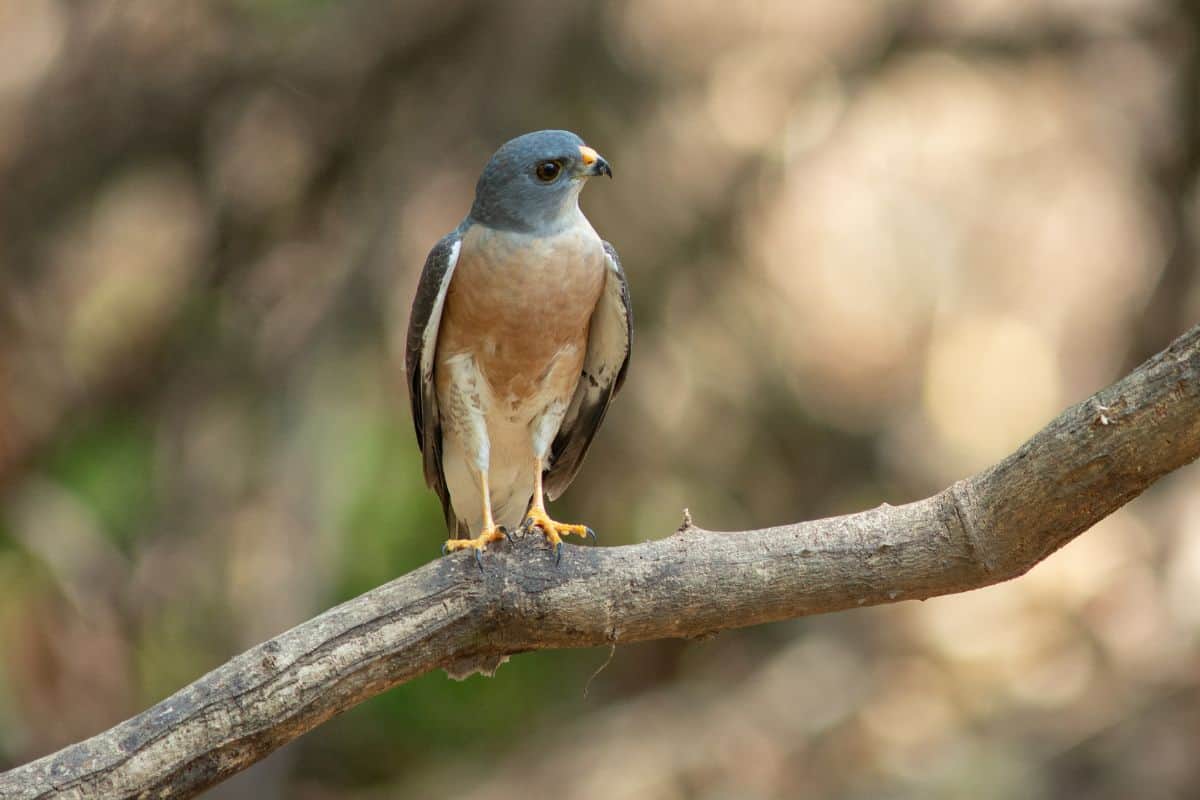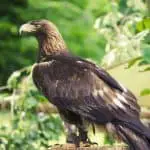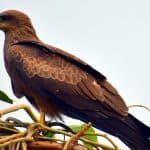Common Name: Chinese Sparrowhawk
Scientific Name: (Accipiter soloensis)| Size | Diet | Range in Hawaii | Status in Hawaii |
|---|---|---|---|
| 12 in. - 15 in. | small birds and insects | Unknown | Least Concern |
The Chinese Sparrowhawk (Accipiter soloensis) is a small but powerful bird of prey that is native to East Asia. With its distinctive plumage and sharp talons, this sparrowhawk is a formidable hunter in its natural habitat. Although it is not a native species to Hawaii, Chinese Sparrowhawks have been spotted occasionally on the islands as non-breeding visitors or vagrants, making for a rare and exciting sighting for birdwatchers.
In this article, we’ll explore the fascinating world of the Chinese Sparrowhawk and learn more about its unexpected presence in Hawaii.
Chinese Sparrowhawk
Appearance

The Chinese Sparrowhawk is a bird of prey with a distinct appearance. It belongs to the Accipiter genus, known for its agile and compact hunting style. The Chinese Sparrowhawk is a medium-sized raptor, measuring approximately 12-15 inches (30-38 centimeters) in length.
This species exhibits sexual dimorphism, with males and females differing in their appearance. The adult male Chinese Sparrowhawk has a slate-gray upper body with fine dark barring. Its underparts are predominantly white with fine streaks or bars. The male has red eyes and yellow legs. In contrast, the adult female has a brown upper body with dark barring and a whitish underside that is heavily streaked.
Both males and females have a short, rounded wing shape, which aids in their quick maneuverability during flight. They also possess sharp, hooked beaks for capturing and tearing their prey. Overall, the Chinese Sparrowhawk displays a compact and powerful build, characteristic of birds of prey in the Accipiter genus.
Diet
The diet of the Chinese Sparrowhawk primarily consists of small birds and insects. As an agile and adept hunter, it relies on its quick flight and maneuverability to capture its prey. The Chinese Sparrowhawk is known for its ability to pursue and catch small birds in flight, often ambushing them from cover or launching surprise attacks. It may also hunt birds by actively searching for them while perched or flying through wooded areas.
In addition to birds, the Chinese Sparrowhawk supplements its diet with a variety of insects. It may feed on insects such as grasshoppers, beetles, and dragonflies, especially during the breeding season when they are more readily available. This bird of prey has sharp, hooked beaks and strong talons that enable it to seize and dispatch its prey effectively.
Nesting
The Chinese Sparrowhawk follows a pattern of nesting typical to the Accipiter genus. It constructs its nest in trees, usually at a considerable height above the ground. The nest is built using twigs, branches, and leaves, forming a sturdy platform that provides a secure foundation for the eggs and growing chicks.
The female Chinese Sparrowhawk takes the primary responsibility for nest construction, although the male may assist in gathering materials. The nest is typically located in dense forests or wooded areas, providing the necessary cover and protection for the nesting pair and their offspring.
Breeding season for the Chinese Sparrowhawk typically occurs during the spring and early summer. The female lays a clutch of two to four eggs, which are incubated primarily by her for approximately 30 to 35 days. During this incubation period, the male may assist in providing food for the female.
Once the eggs hatch, both parents participate in the feeding and rearing of the chicks. The young Chinese Sparrowhawks remain in the nest for several weeks, dependent on their parents for food and protection. As they grow, their flight feathers develop, and they begin to exercise their wings in preparation for fledging.
After about 35 to 40 days, the chicks leave the nest, a process known as fledging. However, they may continue to rely on their parents for food and guidance as they gradually gain independence and develop their hunting skills.
Behavior
The Chinese Sparrowhawk is a fascinating bird with a range of behaviors that showcase its adaptability and predatory prowess. With its swift flight and agility, it employs a “dash-and-catch” hunting technique, surprising and capturing prey in mid-air.
Ambushing its targets, it patiently waits in cover, launching powerful attacks with its sharp talons. During the breeding season, the Chinese Sparrowhawk becomes territorial, fiercely defending its nesting territory from intruders through aerial displays and chases.
As migratory birds, they undertake seasonal movements, breeding in China and Korea and migrating to warmer regions for the winter. While typically solitary, they form monogamous pairs during the breeding season.
Habitat

The Chinese Sparrowhawk occupies a diverse range of habitats throughout its distribution. It is primarily found in forested areas, including deciduous, coniferous, and mixed forests. These birds are particularly associated with wooded habitats that offer a combination of trees for perching and hunting, as well as open areas for flight and foraging.
Within forested habitats, Chinese Sparrowhawks show a preference for edge environments where the forest meets clearings or open areas. Such edges provide them with a strategic vantage point for hunting and an opportunity to spot potential prey. They are also known to inhabit secondary growth forests, plantations, and even urban areas with significant tree cover.
The Chinese Sparrowhawk’s habitat selection is closely tied to the availability of prey, particularly small birds and insects. They are commonly observed in areas with a high density of songbirds, as these birds form a significant part of their diet. Suitable habitat also includes areas with abundant vegetation for nesting and roosting, along with nearby water sources for drinking and bathing.
Range
The Chinese Sparrowhawk is a rare visitor to Hawaii, with limited sightings within the islands. It primarily breeds in China and Korea and winters in the Philippines, Southeast Asia, and Indonesia. While on migration, it has been occasionally observed in western Micronesia, including Yap, Palau, Guam, and the Northern Mariana Islands.
In Hawaii, there is only one confirmed record of a Chinese Sparrowhawk. In September 1991, an adult female was found weak and malnourished on Kure, one of the Northwestern Hawaiian Islands.
This sighting represents the sole documented occurrence of this species in the Western Hemisphere. The Chinese Sparrowhawk’s range in Hawaii is sporadic, making its presence a notable event for bird enthusiasts and researchers.
Conservation Status
The conservation status of the Chinese Sparrowhawk is currently of least concern according to the International Union for Conservation of Nature (IUCN). However, like many bird species, the Chinese Sparrowhawk faces several conservation challenges that require ongoing monitoring and management.
The primary threats to the Chinese Sparrowhawk’s population include habitat loss and degradation due to deforestation, agricultural expansion, and urbanization. These activities result in the destruction of their preferred forested habitats and can lead to reduced prey availability. Fragmentation of their habitat also poses a risk, as it can disrupt their breeding and foraging patterns.
Interesting Facts
1. Agile hunter
Chinese Sparrowhawks are skilled and agile hunters. They use their sharp talons and strong flight capabilities to capture prey, primarily small birds, including sparrows, finches, and warblers. They are also known to feed on insects, lizards, and small mammals.
2. Vocalizations
Chinese Sparrowhawks are relatively quiet birds, but during the breeding season, they may emit high-pitched calls or engage in courtship displays that involve aerial acrobatics and vocalizations.
3. Bird of prey
As a raptor, the Chinese Sparrowhawk plays a vital role in maintaining the balance of ecosystems. They help control populations of small birds and rodents, contributing to the overall health of their habitats.
4. Seasonal plumage change
Like many other bird species, Chinese Sparrowhawks undergo a molting process, where they shed and replace their feathers. This molt often occurs during the non-breeding season, leading to a change in plumage.
Frequently Asked Questions
1. Can the Chinese Sparrowhawk be kept as a pet?
No, it is not advisable or legal to keep the Chinese Sparrowhawk or any wild bird of prey as a pet. These birds have specialized needs and are best left in their natural habitats.
2. Is the Chinese Sparrowhawk migratory?
Yes, the Chinese Sparrowhawk is migratory. It undertakes seasonal migrations, traveling long distances between breeding and wintering grounds.
3. How long do Chinese Sparrowhawks live?
On average, Chinese Sparrowhawks have a lifespan of around 10 to 15 years in the wild. However, with proper care and protection from various threats, they can potentially live longer.
4. Are Chinese Sparrowhawks diurnal or nocturnal?
Chinese Sparrowhawks are diurnal, meaning they are primarily active during daylight hours. They rely on their keen eyesight and agility to hunt and capture prey during the day.




